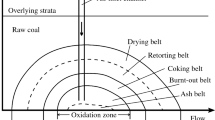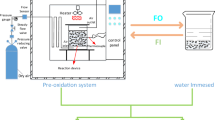Abstract
Long-flame coal is a typical low-ranked coal that is not fully utilized and has a huge global reserve. High-content oxygen is a significant negative factor for low-rank coal utilization. The TG–FTIR–GC/MS method was applied to investigate the migration behavior of oxygen and the variation in the properties of Chinese long-flame coal during low-temperature pyrolysis. It was found that the oxygen migration ratios in long-flame coal toward gas and tar were 47.7 and 5.2%, respectively, at 550 °C, that the initial oxygen migration temperatures of hydroxyl, carboxyl, carbonyl and ether bonds were 500, 200, 300 and 350 °C, respectively, that the decomposition rates were 8.2, 90, 99.2 and 86% at 550 °C, respectively, that the oxygen in gas existed mainly in the form of CO2 and CO, and that the oxygen in tar existed mainly in the form of phenolic compounds. The further removal of oxygen was due to the decomposition of hydroxyl and a small amount of stable ether bonds. Furthermore, deoxygenation suggested that the decrease in oxygen had a positive effect on coal liquefaction and resulted in a decrease in its hydrophilicity.








Similar content being viewed by others
References
Nurhadi M, Efendi J, Lee SL, Mahlia TMI, Chandren S, Ho CS, Nur H. Utilization of low rank coal as oxidation catalyst by controllable removal of its carbonaceous component. J Taiwan Inst Chem E. 2015;46:183–90.
Rao ZH, Zhao YM, Huang CL, Duan CL, He JF. Recent developments in drying and dewatering for low rank coals. Prog Energy Combust Sci. 2015;46:1–11.
Ju YS, Lee CH. Evaluation of the energy efficiency of the shell coal gasification process by coal type. Energy Convers Manage. 2017;143:123–36.
Deng J, Zhao JY, Xiao Y, Zhang YN, Huang AC, Shu CM. Thermal analysis of the pyrolysis and oxidation behaviour of 1/3 coking coal. J Therm Anal Calorim. 2017; doi:10.1007/s10973-017-6331-3.
Soncini RM, Means NC, Weiland NT. Co-pyrolysis of low rank coals and biomass: product distributions. Fuel. 2013;112(3):74–82.
Trautmann M, Lang S, Traa Y. Direct liquefaction of lower-rank coals and biocoals with magnetically separable catalysts as a sustainable route to fuels. Fuel. 2015;151:102–9.
Wang JF, Yan QX, Zhao JT, Wang ZQ, Huang JJ, Gao SP, Song SS, Fang YT. Fast co-pyrolysis of coal and biomass in a fluidized-bed reactor. J Therm Anal Calorim. 2014;118:1663–73.
Rizkiana J, Guan GQ, Widayatno WB, Hao XG, Huang W, Tsutsumid A, Abudula A. Effect of biomass type on the performance of cogasification of low rank coal with biomass at relatively low temperatures. Fuel. 2014;134(9):414–9.
Dlouhý T, editor. Low-rank coal properties, upgrading and utilization for improving fuel flexibility of advanced power plants. In Advanced power plant materials, design and technology. 2010. p. 291–311.
Cormos CC, Starr F, Tzimas E. Use of lower grade coals in IGCC plants with carbon capture for the co-production of hydrogen and electricity. Int J Hydrogen Energy. 2010;35(2):556–67.
Tsubouchi N. Effects of solid residence time and inherent metal cations on the fate of the nitrogen in coal during rapid pyrolysis. Energy Fuels. 2014;28(9):5721–8.
Qu X, Liang P, Zhang R, Gan ZX, Bi JC. Sulfur transformation in the process of circulating fluidized bed combustion combined with coal pyrolysis. Energy Fuels. 2010;24(9):5023–7.
Borislav GA, Manovic V. Influence of non-uniformity of coal and distribution of active calcium on sulfur self-retention by ash-A case study of lignite kolubara. Energy Fuels. 2002;16(4):951–5.
Solomon PR, Hamblen DG, Carangelo RM. Applications of Fourier transform IR spectroscopy in fuel science, coal and coal products. In Fuller EL, editor. Analytical characterization techniques. ACS symposium series 205, Washington; 1982. p. 77.
Xin HH, Wang DM, Qi XY, Qi GS, Dou GL. Structural characteristics of coal functional groups using quantum chemistry for quantification of infrared spectra. Fuel Process Technol. 2014;118(2):287–95.
Lievens C, Ci DH, Bai Y, Ma LG, Zhang R, Chen JY, Gai QQ, Long YH, Guo XF. A study of slow pyrolysis of one low rank coal via pyrolysis-GC/MS. Fuel Process Technol. 2013;116(4):85–93.
Lin YK, Li QS, Li XF, Ji K, Zhang HP, Yu YM, Song YH, Fu Y, Sun LY. Pyrolysares distribution and kinetics of Shenmu long flame coal. Energ Convers Manage. 2014;86:428–34.
Liu HH, Mou JH, Cheng YP. Impact of pore structure on gas adsorption and diffusion dynamics for long-flame coal. J Nat Gas Sci Eng. 2015;22:203–13.
Ma L, Lu D, Liang HD, Zhu SQ, Ding Y, Li S, Chen YF. Preliminary study on macromolecular structure characteristics of Shenhua long flame coal. J Fuel Chem Technol. 2013;41(5):513–22.
Xu Y, Zhang YF, Zhang GJ, Guo YF, Zhang J, Li GQ. Pyrolysis characteristics and kinetics of two Chinese low-rank coals. J Therm Anal Calorim. 2015;122:975–84.
Cui X, Li XL, Li YM, Li S. Evolution mechanism of oxygen functional groups during pyrolysis of Datong coal. J Therm Anal Calorim. 2017;129(2):1169–80.
Dong PW, Chen G, Zeng X, Chu M, Gao SQ, Xu GW. Evolution of inherent oxygen in solid fuels during pyrolysis. Energy Fuels. 2015;29(5):2268–76.
Zhao P, Shi SD. Study on the release of oxygen functional group in Shengli lignite during preliquefaction. J China Coal Soc. 2009;2(3):44–7.
Mráziková J, Sindler S, Veverka LS, Mack JR. Evolution of organic oxygen bonds during pyrolysis of coal. Fuel. 1986;65(3):342–5.
Sharma RK, Wooten JB, Baliga VL, Hajaligol MR. Characterization of chars from biomass-derived materials: pectin chars. Fuel. 2001;80(12):1825–36.
Sharma RK, Wooten JB, Baliga VL, Lin XH, Chan WG, Hajaligol MR. Characterization of chars from pyrolysis of lignin. Fuel. 2004;83(11–12):1469–82.
Geng WH, Nakajima T, Takanashi H, Ohki A. Analysis of carboxyl group in coal and coal aromaticity by Fourier transform infrared (FT-IR) spectrometry. Fuel. 2009;88(1):139–44.
Wang SQ, Tang YG, Harold HS, Guo YN, Gao WC, Lu XK. FTIR and simultaneous TG/MS/FTIR study of late permian coals from southern China. J Anal Appl Pyrol. 2013;100:75–80.
He QQ, Wan KJ, Hoadley A, Yeasmin H, Miao ZY. TG–GC–MS study of volatile products from Shengli lignite pyrolysis. Fuel. 2015;156:121–8.
Charlanda JP, MacPheea JA, Girouxa L, Pricea JT, Khanb MA. Application of TG–FTIR to the determination of oxygen content of coals. Fuel Process Technol. 2003;81(3):211–21.
Liu JX, Jiang XM, Shen J, Zhang H. Pyrolysis of superfine pulverized coal. Part 1. Mechanisms of methane formation. Energy Convers Manage. 2014;87:1027–38.
Tian LN, Yang W, Chen ZH, Wang XH, Yang HP, Chen HP. Sulfur behavior during coal combustion in oxy-fuel circulating fluidized bed condition by using TG–FTIR. J Energy Inst. 2016;89:264–70.
Yan L, Bai Y, Zhao R, Fan L, Xie K. Correlation between coal structure and release of the two organic compounds during pyrolysis. Fuel. 2015;145(145):12–7.
MacPhee JA, Charland JP, Giroux L. Application of TG-FTIR to the determination of oxygen content of coals. Fuel Process Technol. 2006;87(4):335–41.
Artok L, Schobert HH. Reaction of carboxylic acids under coal liquefaction conditions 1. Under nitrogen atmosphere. J Anal Appl Pyrol. 2000;54(1–2):215–33.
Wang HH, Dlugogorski BZ, Kennedy EM. Thermal decomposition of solid oxygenated complexes formed by coal oxidation at low temperatures. Fuel. 2002;81(15):1913–23.
Scaccia S. TG–FTIR and kinetics of devolatilization of Sulcis coal. J Anal Appl Pyrol. 2013;104:95–102.
Fan N, Meng T, Zhang QM. Pyrolysis of low-rank coal: from research to practice. Pyrolysis. InTech; 2017;14:319–39.
Alessio D, Raspolligalletti A, Licursi AM, Martinelli DM. FTIR investigation of the structural changes of Sulcis and south Africa coals under progressive heating in vacuum: correlation with volatile matter. J Combust. 2013;11:1–14.
Huang X, Zhang S, Lin XC, Wang YG, Xu M. Deoxygenation effect on hydrophilicity changes of Shengli lignite during pressurized pyrolysis at low temperature. J Fuel Chem Technol. 2013;41(12):1409–14.
Yang LJ, Ouyang YL, Ke WL, You Y, Li QH. Research on the impact factors of coal wettability. Coal. 2012;21(8):4–5.
Acknowledgements
Financial support by from the National Key R&D Program (Project No. 2016YFB0601501) is gratefully acknowledged. The authors also thank for the suggestion of Dr. Sen Li on this work.
Author information
Authors and Affiliations
Corresponding author
Rights and permissions
About this article
Cite this article
Wang, Z., Wang, C., Kang, R. et al. Deoxygenation of Chinese long-flame coal in low-temperature pyrolysis. J Therm Anal Calorim 131, 3025–3033 (2018). https://doi.org/10.1007/s10973-017-6753-y
Received:
Accepted:
Published:
Issue Date:
DOI: https://doi.org/10.1007/s10973-017-6753-y




